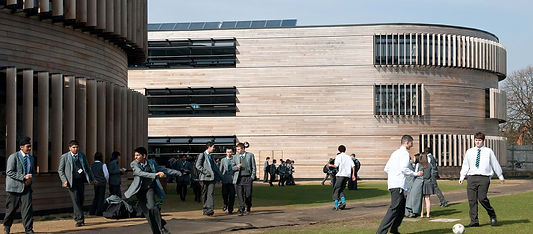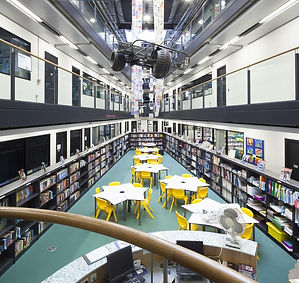CASE STUDY
The Langley Academy in Slough
Project Management, Educational Advice and ICT
3es were Overall Project Managers and also provided educational and ICT advice to the sponsor, the Annabel Arbib Foundation. We managed the risk register, budget, TUPE, recruitment and developed and maintained excellent relationships with the Trades Unions. We set out the Academy’s vision with the sponsor and defined the education and ICT strategies. We developed a thoughtful decant strategy to move the predecessor school into the new academy building with the minimum of disruption to the students’ education. We recruited the Principal, Leadership team and Finance Director, from creating the job descriptions to planning and delivering the interview process.
We worked in partnership with the sponsor and architects, Foster + Partners, and helped design the new building, translating the sponsors’ vision into reality. We held participative workshops with key stakeholders to develop the vision. We also developed the specialisms with the Sponsor resulting in the first British ‘Museum School’ with strong cricket, rowing and science. The sponsor was keen to develop an innovative approach to education in the Academy, yet was initially nervous about this, but after visiting New York City Museum School and through our advice, encouragement and knowledge was convinced that it would work for the Academy.
We developed the ICT vision, resulting in a strategy which covered the whole curriculum and supports the Academy’s specialisms, enhancing teaching and learning opportunities. The functional specification and infrastructure addressed current requirements but took into consideration future technological developments and possible expansion.
Innovation
One of Langley’s specialisms is science. We helped develop the design of the laboratories as circular pods overlooking the main atrium to display the importance of science as soon as visitors enter the Academy. We established links with nearby Eton College and Langley now uses Eton’s online science curriculum materials, and Eton teachers have delivered science master classes. Langley Academy is also able to use Eton’s equipment and facilities for cricket as well as the nearby Dorney Lake for rowing. All academies are different but it is always important to develop links into the community and to raise expectations and the self-esteem of students.

The use of colour in school environments is very important to promote learning. We worked with the sponsor and the architects to produce a vibrant environment which is conducive to learning. Prior to implementing the Academy’s innovative museum learning specialism, we secured additional funds from the government to research whether museum learning actually assisted learning, motivated students and was worth introducing into the Academy. We had some very positive outcomes, which formed the basis for how we worked with the Principal Designate to set up the Academy.
Programme Management
Our programme for the opening of the new Academy building was very tight, and we had a very short space of time to decant everyone from the predecessor school buildings into the new Academy. Langley Academy was delivered on time and to budget when it opened in September 2008.
On the original site, the old school buildings were mostly dilapidated and past their useful life. However, there was one new block which was retained and converted into a sixth form centre, enabling the Academy to recruit a large sixth form.
Langley Academy is sited under the London Heathrow flight path resulting in serious aircraft noise. We had to use mechanical ventilation, which normally means it is difficult to achieve BREEAM Very Good. However, our expertise in BREEAM requirements enabled us to mitigate the problems by planting wild flower meadows, using sustainable materials in the building’s construction and implementing reed beds and other sustainable measures to achieve a Very Good rating. These extra additions to the site are used to as teaching tools and are built into the school’s curriculum.
The sponsor was very keen for the new building to be environmentally ambitious and as sustainable as practicable. Our expertise was exploited through the use of solar panels, a ground source heat pump and a biomass boiler which is actually used. We also liaised closely with Thames Water and arranged for toilets with differing flush mechanisms, one set using rain water and this enables students to monitor the amount of water used in each type.
We held regular meetings with the contractors to discuss progress on the site, and to give them a chance to raise any issues or delays. These meetings also enable us to share knowledge and information between the teams, so everybody is learning all the time.

Stakeholder Management
Our experience from other projects on the Academies programme has enabled us to create a robust risk register, which involves all stakeholders on a regular basis. By taking this action, we know that everyone involved with the project is aware of the important risks associated with the project, and how they can take action to mitigate them. We operate an ‘open door’ policy, which is available to all stakeholders, including local residents, contractors, the other project teams, school and Academy staff, sponsors and other project stakeholders.
We worked with the Arbib Foundation, the sponsor for the Langley Academy, for about four years on this project. Through this time, we developed an excellent working relationship, and built up significant trust. The sponsor knew relatively little about the Academies’ process or education and relied on us to help deliver the project on time, on budget, with a functional building and appropriate education vision. Following the opening, we continued to provide ad hoc support to the Academy and the Arbib Foundation.
In common with all Academy projects, there were a number of key stakeholders with whom we had regular contact. These included parents of students at the predecessor school, parents of the new Year 7 entry, sixth formers and their parents, other schools in the Slough area and the local community, media and businesses. We managed a successful marketing strategy to each of these stakeholders, and ensured they were consulted at each stage of the programme.
An early strong relationship was forged with Slough Borough Council which meant that although the Academy was not governed by them, their support was sought and welcomed in areas such as admissions appeals. They were also supportive in assisting with the difficult relationship that built up between the head of the predecessor school and the Principal Designate.
Consultation
Langley Academy, as with most Academy projects, required consultation with the predecessor school’s staff regarding TUPE. We held detailed consultations with the staff Trade Unions and the staff regarding their transfer to the new Academy. The head of the predecessor school was not very cooperative so this was a particularly delicate consultation period. Our approach enabled proposals which met everyone’s requirements to be put forward and agreed with all parties.
The Academy’s sponsors’ wish for an innovative learning environment for the students meant a departure from ‘standard’ school or Academy design for the project architects, Foster + Partners. We spent significant amounts of time in discussion with the architects, understanding the Academy’s education vision before initial designs were started. We also conducted visits to universities and the British Museum to give the sponsor and the architects ideas on what could be achieved.

Langleywood School, the predecessor school, was a failing school with a poor reputation in an area of significant social deprivation. Through our marketing activity, we were able to ensure the Academy was fully subscribed for its first year of operation, and it is still well-attended and popular. The predecessor school also had a memorial garden from a time when a member of staff and a pupil had both died. The site of this garden was earmarked for the Academy’s sports pitches and had to be moved. We held meetings with the staff, the students and the head at the predecessor school to ensure everybody was comfortable with the new location of the garden.
The new Academy building is very close to a dense residential area, so it was important that we kept the residents and the local Residents’ Association informed through regular meetings and newsletters. There were some initial concerns about the size and location of the building, but these were allayed by our team, and the Academy was well-received when it was opened.
Finance
Many of those involved in Academy finances have a background in private business, and do not necessarily have an understanding of school or Academy finance. Through engagement, we worked to ensure they had confidence in us as the Project Managers, so we helped them gain a good understanding of how Academy budgets operate. In common with all our Academy projects, we attended Finance & General Purposes Committee meetings with the Arbib Foundation and ran workshops covering how Academies operate financially.
When the building costs were first calculated, it became clear that the budget would be exceeded. Through working closely with the sponsor and the architects, we were able to ‘value engineer’ and alter the building so it came in on budget. This required constant ongoing monitoring with the cost consultants and attending regular meetings with the contractors. This was coupled with our own understanding of how buildings are constructed, and what is necessary. While we had to slightly alter the building’s footprint, we also worked to change doors, door furniture, balustrades and some FF&E with the outstanding contactor Reds 10 as well as making use of pre-fabrication to reduce costs. This ensured the project was delivered on budget as well as on time. We also advised the Academy on the ‘start-up grant to assist them in areas such as school development, organisation of learning, Academy governance and marketing/ recruitment activities.
Security
All staff, especially the Finance and ICT Managers were brought on board early to manage the process of student and staff data transfer. We also engaged Slough Borough Council in assisting with the smooth transition and storage of archived data and ensured we complied with relevant Data Protection legislation.
In addition, we developed a robust ICT infrastructure Langley to enhance security and safety. Proximity cards are used to control access to the Academy building and to staff areas, as well as providing the backbone of the registration system. Digital CCTV cameras monitor the entrance, grounds and corridors and the building’s infrastructure is ICT-rich. All moveable ICT and high-value FF&E is monitored and will trigger an alert if they are removed.

